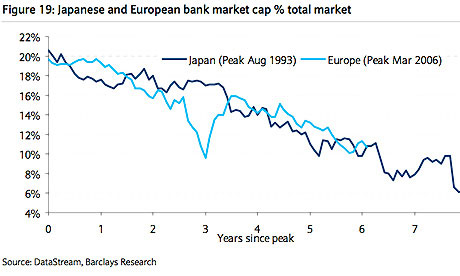Under the Japanese model for handling a bank solvency led financial crisis, bank book capital levels are protected. As a result, losses are only recognized as banks generate earnings in excess of banker bonuses, dividends to shareholders and a de minimus retention of earnings.
From a regulatory perspective, policies like regulatory forbearance are adopted. This facilitates hiding bad loans on and off the banks' balance sheets.
Specifically, the analysts have noticed that banks are hiding their losses.
Japan's economic collapse twenty years ago caused chaos in the banking system. Analysts at the investment banking arm of Barclays are now pointing to similarities between the fate of European economies and their banks.
While the analysts point to differences - Europe's banks are more profitable and not trying to hide their losses in the way Japan's banks did during the 1990s crisis - they also see similarities emerging, in part because of the European Central Bank's long-term refinancing operation (LTRO) which is throwing liquidity at the banks.Clearly, the EU banks are hiding their losses. Just look at the valuation of their sovereign debt exposure to remove all doubt.
Their theory is that European banks will start to hold more sovereign bonds as a result of the LTRO, which happened in Japan post-crisis where banks went from holding 6% of their balance sheets in government debt to more than a quarter now.
This has reduced Japan's private sector credit from 60% of banks' balance sheets to 42% now. Europe's banking sector has 57% of its balance sheet in private sector loans and 4% in government debt at the moment.
But they also reckon that the "clearest evidence" of what they call "Japan-isation" of the banks is the way shares are trading on the stock market.
They write:
Both banking systems reached c20% of their respective stock markets, and six years from peak, both halved to around c10%. Worryingly, Japan's banks then went on decline a further 40% over the next half decade.
The "distinguishing feature" of the Japanese crisis was the way banks kept their bad debts low by lending more to troubled borrowers...Something that is happening in the EU.
But to go back to the similaries, there has been a very similar stock market reaction. Six years on from their peaks both banking sectors have lost half their value.
What might happen next? This chart shows how Japan's banks then went on to underperform the stock market by more than 40%.
The Barclays analysts argue the picture might not be quite as bleak for Europe, as Japan's banks continued to suffer losses as they were slower to recognise bad debts.
They conclude that future "Japan-isation" of European banks would likely require large parts of the system to make retained losses - which they reckon might happen in some parts of the Spanish and UK banking systems.The only way that the EU banking systems will recognize their bad debt faster than Japan has is if the Swedish model for handling a bank solvency led financial crisis is adopted and banks are required to recognize their losses.

No comments:
Post a Comment